The Invisible Enemy

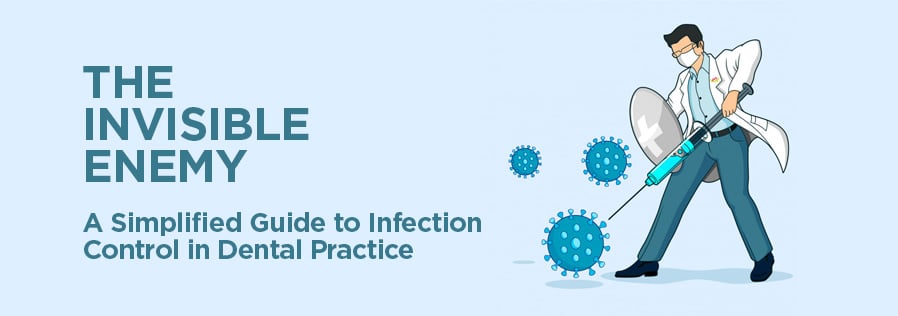
Nothing could have made a harsher lesson that infection control in health services is as vital as the services themselves than the COVID-19 pandemic. Among the myriad of health services challenged by the crisis, dentistry stands apart with the most to lose. And we don’t need an AI based statistical analysis to see that the crisis is far from over. Two things are certain. It won’t be over until we have all been vaccinated, and not until we have a good understanding of the novel coronavirus. For now, prevention is the only cure and infection control the best way forward.
This article aims to provide dentists, hygienists, and dental practice business owners with a simplified guide to the latest thinking and best practices in infection control. It is not a scientific paper, but a practical, user-friendly reference and resource for dental practices across Australia that aim want to build a resilient practice into the future.
While drawing from international research and insights, our focus is on Australian government and regulators’ guidelines, to ensure dental professionals can easily and confidently navigate and apply relevant rules to achieve professional and business success.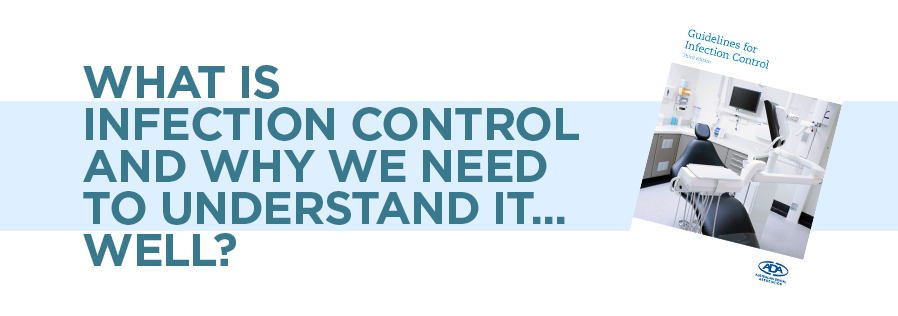
According to ADA Guidelines for Infection Control Third Edition, “the purpose of infection control in dental practice is to prevent the transmission of infectious pathogens, from dental practitioner and dental staff to patients, and from patients to dental staff. In addition, it is necessary that endogenous spread of infection is also prevented by limiting the spread of infectious agents to the broader community.”
Infectious diseases have literally “plagued” humanity since the dawn of time. Clear references to infection control rules can be found in the Bible. They outline specific procedures including “doctor” and patient hygiene, disposal of medical waste and isolation of the sick. Many of these disease prevention rules have become cultural and religious customs of entire nations and geographic regions.
However, the age of reason and modern science have made us less personally vigilant and more reliant on solutions that come from the laboratory. And, while relying of science is an essential part of progress, the risk of infection remains the flip side of the health system.
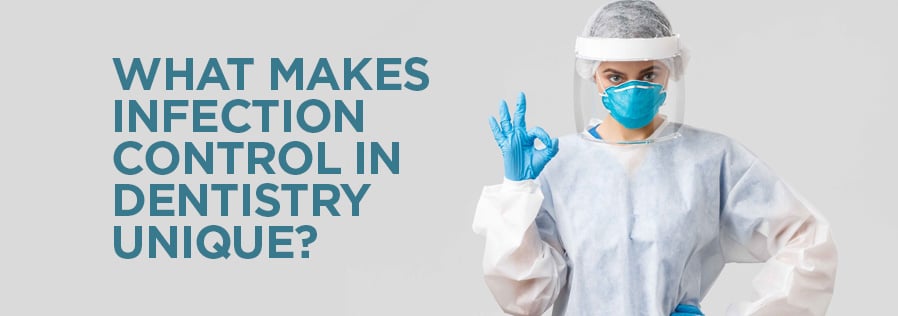
As a subset of the broader health system, dentistry stands uniquely apart. This is because in dental practice infection can occur through a disproportionate range of means compared to most health services. It can be inhaled, implanted, ingested, injected, or splashed as well as transmitted from person to person through touch, or through equipment and tools used in daily procedures.
“What diseases can I catch at the dentist?” This is one result for which you don’t normally want your dental practice to be found in the Google search.
According to the Canadian Dental Association, “In addition to the bloodborne pathogens (BBPs) — e.g. HIV, hepatitis B and C viruses, other viruses of concern in the dental office include rubella, mumps, measles; the herpes viruses, varicella-zoster, Epstein-Barr virus [EBV], human papilloma viruses; adenovirus; coxsackie viruses; and the upper respiratory tract pathogens (influenza A and B viruses, human parvovirus B19 and respiratory syncytial virus). Most of these are far more prevalent than the BBPs.“
Although there is considerable knowledge about most of these infectious diseases, including vaccines for many of them, from time to time we are faced with something completely new and alien. The SARS-CoV-2, the virus that causes COVID-19 is just the latest pandemic. Due to the above risks, the dental services industry was sidelined pushed into closure as non-essential, instead of contributing and providing essential services during the crisis. This is based on a paper by Sydney University.
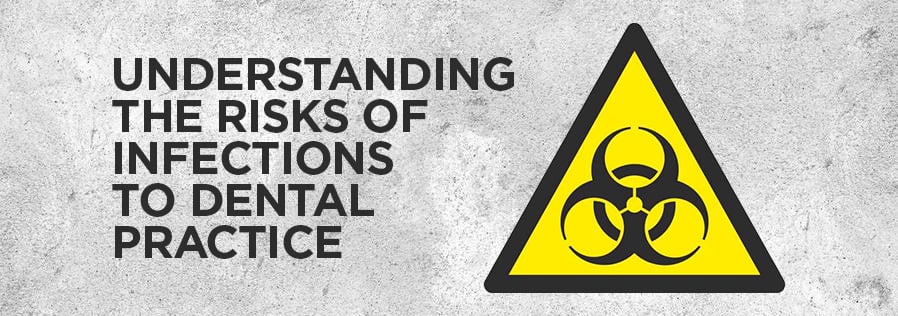
The abbreviated list is a reminder of the enduring risk of infections in dental surgery, now greatly increased by the invisible enemy, COVID-19. A year since its outbreak, we are beginning to learn how to co-exist within the COVID-19 pandemic and while vaccination has become available, the threat of infection continues to be high.
Let’s be blunt. Just as one cannot be a little pregnant or a little dead, for a dental practice there is no such thing as a little case of infection outbreak. Any breach in adherence to rules and best practices comes with a price most practices cannot afford.
In the case of COVID-19 it means instant shut down and quarantine, plus, it has a long tail effect of regulatory issues, which translates into loss of time and revenue.
Any other breach in hygiene protocol is subject to sharing on social media, Google reviews, and bad word of mouth in the local community. In this day and age of instant news and social media, business reputation is hard currency.
Every detail matters. One missed step, one moment of omission in what should be culturally ingrained behaviour in your practice, can result in loss of patients, revenue, reputation, or worse, somebody’s health. It could be yours or your loved ones.
Therefore, it is critical that every member of the dental practice has a deep understanding of the importance of infection prevention and the risks and implications of a breach in infection control protocols.
The bottom line? When your infection prevention and control (IPC) system fail, losing business may be the very least of your problems.
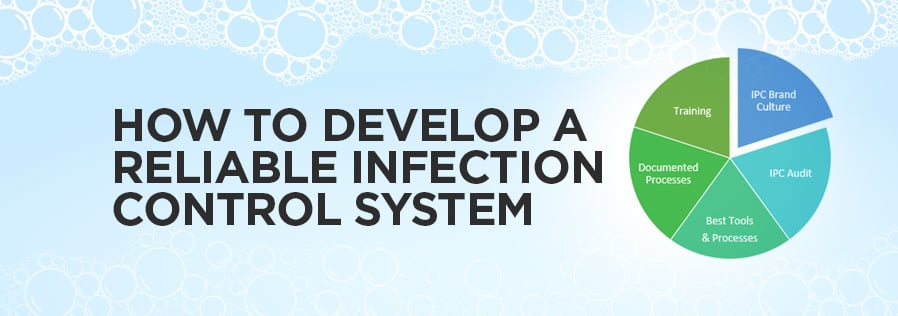
To be effective, an infection control management system for dental practice must be endorsed by the business leadership, fully embraced by all employees, based on best practice and include the latest relevant industry and government regulations. Most of all it needs to be simple.
The following steps, detailed below, provide a useful framework designing such system:
1. Infection Control Audit
2. Adopting Best Processes and Tools for Infection Control
3. Continuous Training and Learning
4. Documented Processes – the Legal Imperative
5. Building an Infection Prevention Brand Culture
1 INFECTION CONTROL AUDIT
To improve, we need to measure. The first step in developing an effective infection prevention and control system is to identify every point of risk in the dental practice. No shortcuts, if you haven’t done it yet, the practice needs to instigate a formal and comprehensive Audit.
The starting point is the Dental Board of Australia website. It provides industry approved Guidelines for infection control management, including a downloadable self-audit tool, designed to help practitioners comply with the Board’s guidelines in their workplace
Many practices don’t have the time or resources to do their own audit or want to ensure it is conducted thoroughly by a skilled specialist. If that is you, search Google for “dental practice infection control audit” and investigate relevant service providers. A reputable auditor will give you peace of mind in ensuring health and business safety for your practice.
2 ADOPTING BETTER TOOLS FOR INFECTION CONTROL
Almost every dental procedure uses rotary dental and surgical instruments, such as handpieces or ultrasonic scalers and air-water syringes. Together with the work practices used in a dental surgery, these essential tools of trade create the perfect vector for infection transmission opportunities.
While hand hygiene, PPE and clothing, cleaning and sterilisation techniques provide considerable protection, dental practices can take advantage of the latest innovations in dental tools and equipment to close the circle.
One tool that deserves special attention is the dental bur. It is one of the most used tools in dentistry. Covid 19 reopened the debate on reusable vs single use burs. It seems that the jury is out with the verdict in favour of the economy of single-use burs, led by products such as Microcopy's NeoDiamond and NeoBurr.
A thorough audit and focus on safety will help re-examine other high-risk tools and equipment to develop game changing strategies for a more successful practice.
3 THE IMPERATIVE OF DOCUMENTING IPC PROCEDURES
There are two core reasons why every dental practice must have their infection Prevention and Control processes properly documented:
o Professional Responsibility
o Legal Obligations
Like all health professionals, dental practitioners have a professional ethical obligation to “do no harm”, which relates not only to what they do, but also to what they neglect doing that may cause harm.
Under Australian law the onus of proving “no wrong-doing”, i.e. proving innocence in failing to prevent infection, falls on the dental practitioner.
The Fact Sheet provided by the Dental Board AHPRA informs us that when there is a complaint (read also: infection breach) against the practice and a practitioner, the dental practice will be required to provide a copy of its infection control manual they will also have to demonstrate evidence that all staff have access to this manual as well as photographs of the layout and the equipment used in the sterilisation area, and printouts of results of autoclave cycles over a period.
4 CONTINUOUS TRAINING FOR INFECTION CONTROL
Infection control measures applied within dental practices are generally safe and effective. What makes a difference in a crisis is when comprehensive routines, based on officially approved best practice guidelines, are understood, strictly observed and implemented by the entire team.
Standard Precautions for infection control, outlined in detail in the ADA Guidelines for Infection Control forms a framework for developing effective infection control procedures, training and manuals. They address six key focus areas of infection control and prevention in a dental practice:
1 Hand Hygiene
2 Personal Protective Equipment
3 Surgical procedures and aseptic technique
4 Management of sharps (better choices, disposal risks, cost, risks)
5 Management of clinical waste
6 Environment management (cleaning and disinfecting)
Education and training are critical elements of Standard Precautions and it is recommended that staff compliance with workplace infection control protocols be a key element of their performance assessment.
In addition, the Dental Board of Australia provides a simple set of Guidelines on Infection Control, that are binding under national law . These Guidelines require that all registered dental practices and registered dental practitioners must have access to specific Documentation and display specific Behaviours that prevent and minimise the risk of spreading infectious diseases:
1. A manual of infection control protocols and procedures used in that practice, which is based on resources listed in following points.
2. The latest version of AS/ NZS 4815 or AS/NZS 4187 – which covers cleaning, disinfecting and sterilising reusable medical and surgical instruments and equipment, and maintenance of associated environments in health care facilities (available at: www.safetyandquality.gov.au).
3. NHMRC Australian Guidelines for the Prevention and Control of Infection in Healthcare (available at: http://www.nhmrc.gov.au/publications/synopses/cd33syn.htm)
4. The current ADA Guidelines for Infection Control (available at: http://www.ada.org.au).
These simple guidelines should form the core of the Procedures and Training documentation of a dental practice.
5 BUILDING A BRAND CULTURE OF INFECTION CONTROL IN DENTAL PRACTICE
As mentioned above, to be effective, infection control procedures must be simple. The most effective way to implement them is by building an infection control driven culture. Brand or business culture is how organisations 'do things'. It is at its best is when leaders lead by example and employees do the right thing even when nobody is watching.
The critical factor here is the leadership commitment to building infection prevention brand culture. A strong sign of such commitment is gaining Dental Practice Accreditation to the National Safety and Quality Health Service Standards.
Unlike dental hospitals and public health dental services, the NSQHS Accreditation has not been previously available for private dental practices. While it’s not compulsory, it offers multiple business benefits. The only risks lie in NOT getting accreditation. It may make your practice less prepared for the latest infection control regulations and preventing it from rebuilding public trust in the post-COVID-19 era.
ESSENTIAL GUIDELINES FOR DENTAL INFECTION PREVENTION AND CONTROL
The following are key nationally binding resource for infection control in dental industry in Australia. Note that there are some additional compliance regulations relating to specific states and territories. It is important to cross check your policies and procedures for accuracy and websites of the Australian Dental Association, and the Dental Board of Australia will provide relevant contacts and further extensive resources.
1 ADA Guidelines for Infection Control Third Edition 2015 – PDF
https://www.ada.org.au/Dental-Professionals/Publications/Infection-Control/Guidelines-for-Infection-Control/1ADA_GuidelinesforInfectionControl_3.aspx
2 Dental Board – AHPRA provides Guidelines on Infection Control as a refreshingly short summary of guidelines, codes and other resources necessary to adopt practices that ensure public health and safety and minimize the risk of spreading infectious diseases.
o https://www.dentalboard.gov.au/codes-guidelines/policies-codes-guidelines.aspx
o https://www.dentalboard.gov.au/Codes-Guidelines/Infection-control-obligations-of-dental-practitioners.aspx
3 Australian Hand Hygiene Association, HHA, provides extensive resources for hand hygiene, including the WHO’s 5 Moments for Hand Hygiene.
https://www.hha.org.au/hand-hygiene/5-moments-for-hand-hygiene
https://www.hha.org.au/audits/audit-tools/dental - audit tools
4 The Australian Commission on Safety and Quality in HealthCare provides comprehensive and well-curated information on infection control standards in Australia.
o Infection Prevention and Control in hospital environment - https://www.safetyandquality.gov.au/standards/nsqhs-standards/preventing-and-controlling-healthcare-associated-infection-standard
o https://www.safetyandquality.gov.au/standards/national-safety-and-quality-health-service-nsqhs-standards/assessment-nsqhs-standards
o Infection prevention and control systems: https://www.safetyandquality.gov.au/standards/nsqhs-standards/preventing-and-controlling-healthcare-associated-infection-standard/infection-prevention-and-control-systems
5 Dental practice Infection Control Accreditation – ADA Australia: https://www.ada.org.au/Your-Dental-Health/Adults-31-64/Practice-Accreditation
In summary, the COVID-19 pandemic is a timely reminder of the importance of infection prevention and control as a constant state of readiness for any unexpected health crisis. The process must be ingrained in every person working in healthcare, in any capacity, from the CEO to the contract cleaner and security guard. It is a systemic challenge and the only way to succeed is to keep it simple. Hence this simplified guide to Infection Control for dental practice.
If you need extra information or assistance in choosing the best options of dental tools and supplies for your practice, please call 1800 422 227. And feel free to visit https://www.arkhealth.com.au/